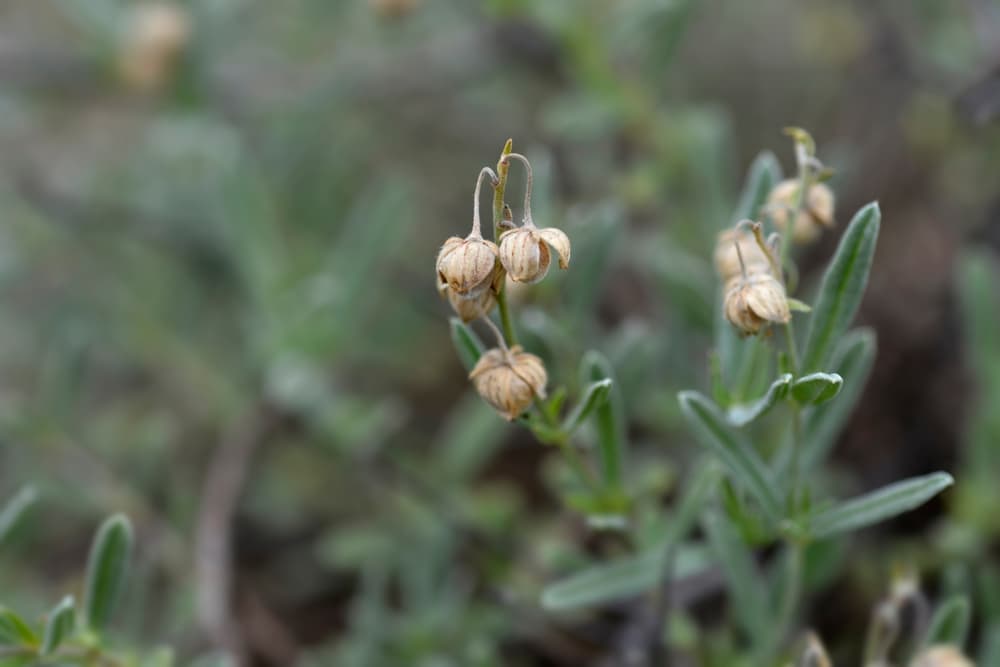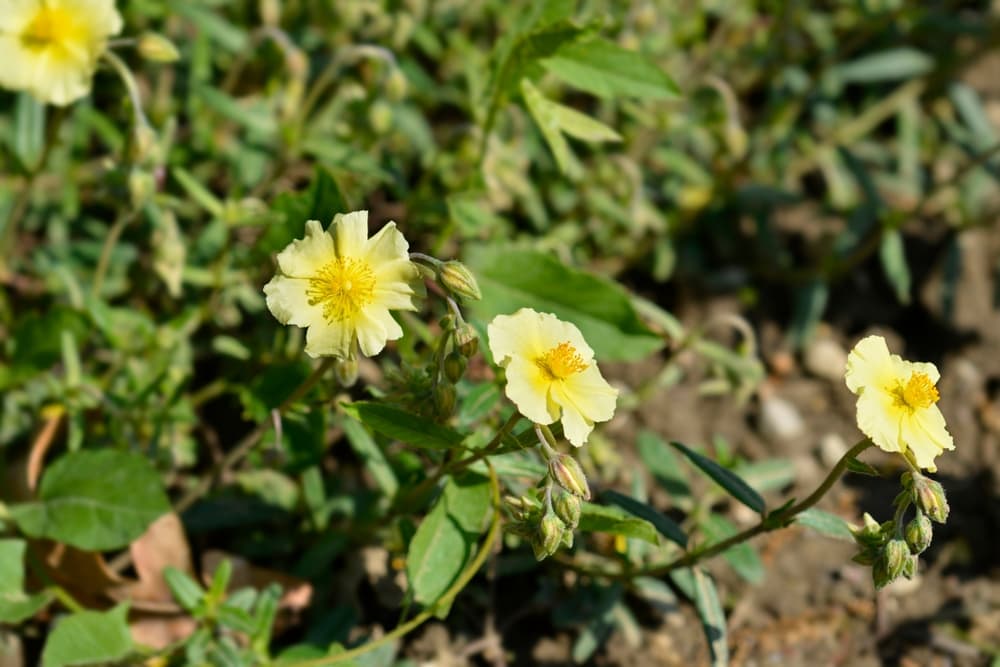SHRUBS > HELIANTHEMUM
Reviewed By COLIN SKELLY

Colin is a Horticulturist and Horticultural Consultant with experience in a range of practical and managerial roles across heritage, commercial and public horticulture. He holds the Royal Horticultural Society’s Master of Horticulture award and has a particular interest in horticultural ecology and naturalistic planting for habitat and climate resilience.
IN THIS GUIDE
Only about a foot high, Rock Rose shrubs offer advantages few plants of that size do.
It is a no-care option that gets by in conditions that other flowering plants wither in – poor soil, aridity, and sea-spray are as if nothing.
It provides year-round low-growing foliage of a cool green hue and oodles and oodles of simply delightful flowers from pastel yellow to ruby red.
Overview
| Botanical Name | Helianthemum |
| Common Name(s) | Rock Rose |
| Plant Type | Shrub |
| Native Area | Europe, South-West Asia |
| Hardiness Rating | H5 |
| Foliage | Evergreen |
| Flowers | Various |
| When To Sow | May, June, July, August, September |
| Flowering Months | June, July, August, September |
Sunlight
Preferred
Full Sun
Exposure
Exposed or Sheltered
Size
Height
0.1 – 0.5M
Spread
0.1 – 0.5M
Bloom Time
May – September
Soil
Preferred
Most soil types
Moisture
Moist but well-drained or well-drained
pH
Any
Helianthemum is a genus of 112 species of low-growing evergreen shrubs and subshrubs plus a few herbs that inhabit Europe, Northern Africa, and South-Western Asia.1Helianthemum. (n.d.). Kew Royal Botanic Gardens. Retrieved June 13, 2023, from https://powo.science.kew.org/taxon/urn:lsid:ipni.org:names:30002303-2#children
Members of this genus grow in numerous and varied habitats from oceanside cliffs to interior grasslands, and from highland meadows to rocky barrens.
Helianthemum nummularium cultivars are spreading, mat-forming evergreens that are as if tailor-made for specific garden purposes like floral designs, groundcover, rock gardens, and low edging.

Those Helianthemum species that have ornamental value and all of the cultivars are also formally named ‘Rock Rose’ though the genus as a whole with all its species is also sometimes informally referred to as Rock Rose.
Be aware that – very confusingly – the related genus Cistus is also sometimes called Rock Rose.
These spreading shrubs and subshrubs grow from about 20-50cm.
Barring a few exceptions, all of the in-demand varieties reach heights of 25-35cm.

This little plant’s small leaves are opposite; on some species the upper stems’ leaves are alternate.
In the majority of varieties, the foliage is a subdued but coolly attractive greyish-green or bluish-green shade.
Because of this tone and texture of the foliage, these plants are also called Frostwort.
Interestingly, the shape of the leaves varies quite a bit even among the cultivars, varying from linear to ovate with the majority being lanceolate or elliptic.

The arrangement of the flowers varies by species – they may be single or borne in some or another type of inflorescence.
Flowers are always five-petalled and are disk-shaped or saucer-shaped.
They are delightfully pretty and though the blooms last for but a day, these shrubs are incredibly prolific.
Rock Rose plants typically bloom from late spring to midsummer, and profusely at that.
Habitat & Growing Conditions
These plants almost always grow in sunny locations, and most are lime-loving plants that grow well in chalky, calcareous soils.
Apart from these two common factors they grow in semi-desert, grassland, field, hilly, and coastal locations.
None of the species or cultivars need fertile soil and in nature, the species frequently grow in even stony and gravelly ground.

All the desirable varieties are hardy to Zone H4, making them just hardy enough for almost the entire United Kingdom.
How To Grow Rock Rose
The very name Rock Rose is an indicator of where you can plant this tough but delightful shrub.
It can make do in poor, gravelly or stony soil, and it is one of the best choices for rock gardens.
These shrubs are perfect for narrow borders where you want low-growing plants.
Any strips of indifferent soil, such as between a walkway and a dwelling’s wall, or between a driveway and a tiled courtyard, can be greened (and flowered) wonderfully well by Rock Rose varieties.
Rock Rose varieties are excellent choices for groundcover on barren slopes and verges where the spreading mats will both control erosion and provide all-year greenery.

In coastal locations that are windswept, have salt-sea air, and sandy ground where you will be hard-pressed to grow any flowering plants, Helianthemum will prove to be a godsend.
Lastly, you can grow this plant between paving slabs and stones, and between paving slabs and bordering concrete to control erosion, crumbling, and to hold the ground and slabs together.
“I use Helianthemum in two main ways: in the cracks and gaps of stone walls and between paving stones in gravel areas” shares Horticulturist and Garden Consultant Colin Skelly.
“I always grow them in full sun. This environment reflects quite closely the habitat range of wild Helianthemum populations.”
Growing From Seed
Helianthemum can be grown from seed.
This can be done indoors at the break of spring for transplanting outdoors in late spring, or the seeds can be sown directly outdoors in late spring which is the more straightforward option.

Scarify and soak about half your seeds before sowing. Sow seeds on the surface and very lightly cover them with a sprinkling of soil.
Water them well and keep watering frequently – they usually take 15 to 20 days to germinate.
Plant Care
The only no-nos for Helianthemum are heavy clay soils and acidic soils, and full shade. Other than that, anything goes.
Preferred Soil
Even though this is a lime-loving genus do not plant it in heavy clay soils.
Indifferent soil is fine so long as it is alkaline – but if you have chalky soil and want to plant Rock Rose, you are in luck.
A light, friable soil made up of gravel, sand, and chalk amended with just a little organic compost or humus will work out very well for all Helianthemum.

They do not care for rich soils – the soil pH may be from Neutral to Moderately Alkaline – 6.6 to 8.4.
Soil must drain well and should not stay damp, while the location should offer full sun or at least partial sun.
Watering
Gradually reduce the amount and frequency of watering as the plants grow.
After they have matured they should be watered only when the soil dries out.
As a guideline, about one centimetre of water twice a week should be enough.
In the country’s colder regions it would be wise to mulch Helianthemums.
Fertilising
Fertilising is not needed but if you would like to try to boost the number of blooms over the season or its length, you can feed the plants once in mid-spring using a small amount of high potassium liquid fertiliser.
Do not use a balanced fertiliser or one meant for ericaceous plants.

Pruning
Rock Rose does not need any pruning. However, you may prune them for two reasons:
- If you want the plants to stay close to the ground and form a mat-like groundcover, you can prune old woody stems in early spring.
- In favourable climates, you may be able to stimulate a second bloom in late summer or early autumn by cutting back the shrubs by about a third.
Common Problems
Rock Rose is not known to suffer from any pests or diseases.
References
- 1Helianthemum. (n.d.). Kew Royal Botanic Gardens. Retrieved June 13, 2023, from https://powo.science.kew.org/taxon/urn:lsid:ipni.org:names:30002303-2#children


